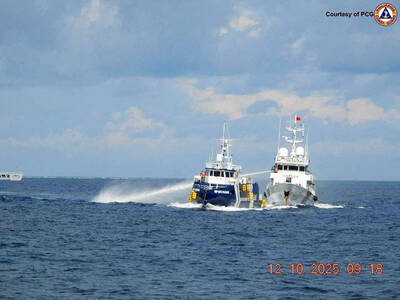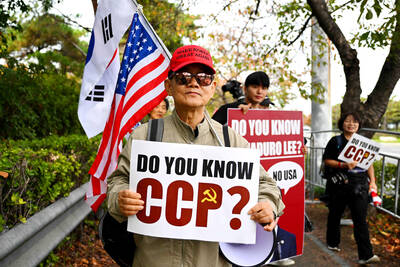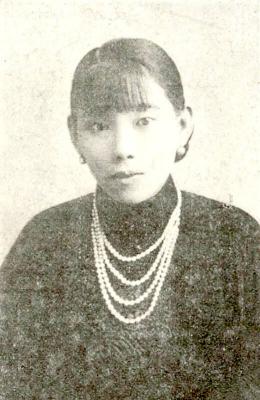Two exhibitions currently on show highlight both old and new art techniques and mediums, yet show that ultimately it is the artists' ideas that wins out. Wang Wan-chun's (王萬春) current show of paper-cut works at the Chi-Wen Gallery contains small, framed pictures that resemble painted Surrealist land-scapes, but were made by cutting quality Japanese paper with knives or scissors, and overlaying colors to create depth and spatial dimension.
Paper cutting is a tradition in Taiwan. Years ago, countryside shamans visited families to fashion paper cut-outs in their likeness, which they painted with a calligraphic brush to further depict their faces. Armed with these symbolic paper figures, the shamans would then chant blessings for the entire family. Legend has it that these shamans remained celibate in order to keep their paper spells potent.
Wang remembers such cultural traditions, often basing his images from well-loved Chinese myths such as the Tales of the Monsters From the Six Dynasties and Strange Tales of Liaozhai, which are ripe with super-natural beings and monsters. His imagery shows vast, nightmarish landscapes of lost wandering souls, decapitated heads, ominous skies, and bestial figures, which he contrasts with the image of a tranquil mountain or a trickling waterfall. Wang is at his best when he focuses on detail. Small, clearly delineated shapes such as a turtle boast finely cut lines; the horizon lines of many of his pictures, on the other hand, are not evenly curved lines -- they virtually quiver and shake with raw emotion.

PHOTO COURTESY OF CHI-WEN GALLERY
After Dark is a group show of graduate students in the digital arts department of the Taipei National University of the Arts (in Guandu) at the Huashan Cultural Center. Seeing the work of young students is thrilling -- like watching a horse race. That is, spectators are often tempted to bet which artists will be in the art world for the long run. Most of the works on view are video-based and require minimum lighting for optimal viewing. It is the hope of many in the nation's art scene to make Taiwan a digital artist's paradise, and as this exhibition demonstrates, local art universities are turning out some talented and technically skilled artists.
Lin Jiun-shian's interactive work asks for the viewer to hold the flame of a lighter to the monitor screen. A heat sensor then triggers a change in the projected images, which allude to the local custom of devotional paper burning.
Kuo Zhong-kuan's (

PHOTO COURTESY OF KUO I-CHEN
Such spiritual voids in technology-based art is exemplified by Chang Po-chih's (
Kuo I-chen (郭奕臣) is definitely an artist to keep an eye on. For him, technology is merely a means to convey his meaning, and is not the be-all and end-all. In the nostalgic Beyond the Liminal Zone, a small sculpture of a house displays the nervously staccato images of the urban scene outside the gallery, which is recorded by six cameras.
Chen Chih-chien's (陳志建 ) projection on a screen suspended above the viewer's head shows sped-up footage of the Ximending area. This is an effective way to communicate that we cannot keep up with the pace of technological development, nor can we arrest time.
Exhibition notes:
What: Wang Wan-chun (王萬春) Spirit of Youth and Passion, Paper-cut art
Where: Chi-Wen Gallery 3F, 19, Ln 252, Dunhua S Rd Sec 1, Taipei (台北市大安區敦化南路一段252巷19號3樓)
Telephone: (02) 8771-3372
When: Tuesday to Saturday, 11:00am to 7:00pm through June 24
What: After Dark, Taipei National University of the Arts graduate students' show
Where: Huashan Cultural Center (華山文化園區), 100 Bade Road Sec 1, Taipei (台北市100八德路一段一號).
On the net: www.aga.org.tw
Telephone: (02) 2321-4808
When: Until May 28

Many people noticed the flood of pro-China propaganda across a number of venues in recent weeks that looks like a coordinated assault on US Taiwan policy. It does look like an effort intended to influence the US before the meeting between US President Donald Trump and Chinese dictator Xi Jinping (習近平) over the weekend. Jennifer Kavanagh’s piece in the New York Times in September appears to be the opening strike of the current campaign. She followed up last week in the Lowy Interpreter, blaming the US for causing the PRC to escalate in the Philippines and Taiwan, saying that as

US President Donald Trump may have hoped for an impromptu talk with his old friend Kim Jong-un during a recent trip to Asia, but analysts say the increasingly emboldened North Korean despot had few good reasons to join the photo-op. Trump sent repeated overtures to Kim during his barnstorming tour of Asia, saying he was “100 percent” open to a meeting and even bucking decades of US policy by conceding that North Korea was “sort of a nuclear power.” But Pyongyang kept mum on the invitation, instead firing off missiles and sending its foreign minister to Russia and Belarus, with whom it

The Chinese Communist Party (CCP) has a dystopian, radical and dangerous conception of itself. Few are aware of this very fundamental difference between how they view power and how the rest of the world does. Even those of us who have lived in China sometimes fall back into the trap of viewing it through the lens of the power relationships common throughout the rest of the world, instead of understanding the CCP as it conceives of itself. Broadly speaking, the concepts of the people, race, culture, civilization, nation, government and religion are separate, though often overlapping and intertwined. A government

Nov. 3 to Nov. 9 In 1925, 18-year-old Huang Chin-chuan (黃金川) penned the following words: “When will the day of women’s equal rights arrive, so that my talents won’t drift away in the eastern stream?” These were the closing lines to her poem “Female Student” (女學生), which expressed her unwillingness to be confined to traditional female roles and her desire to study and explore the world. Born to a wealthy family on Nov. 5, 1907, Huang was able to study in Japan — a rare privilege for women in her time — and even made a name for herself in the